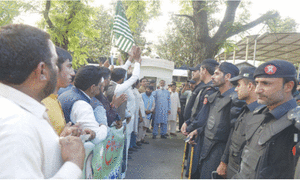The return of women’s international cricket to Pakistan was marked by Sana Mir's side comprehensively whitewashing Bangladesh in the T20 and ODI series held in Karachi.
Pakistan’s success was built upon several solid performances but its architect was 24-year-old Bismah Maroof, who won three consecutive player of the match awards through her all-round efforts.
In the two T20s and ODIs, the left-handed Bismah scored 109 runs and 133 runs, respectively, but also bowled some useful legbreaks to constrict the Bangladesh batting line.
Bismah caught up with Dawn at the end of the Bangladesh series and spoke candidly about the state of women's cricket in the country, idolising Michael Clarke and Virat Kohli and how the 2010 Asian Games gold medal provided a major boost to her side.
Q. Sportswomen have always struggled to get recognition in Pakistan. What was it that pushed you to pick up the bat?
A. Like every typical Pakistani household, the craze for cricket was always there in our family too. I was inspired by my father and brothers who loved the game and started by watching matches with them on TV.
Occasionally, I would play with them too. But my father always wanted me to become a professional cricketer and so I decided to give it a shot and went for trials in Lahore. That's where it all started.
Q. There is a general perception that only girls belonging to a certain economic class are playing cricket and getting selected in the national side. Is there any truth to the claims?
A. It does not matter what financial background you belong to if you’ve got full support from your family to become a cricketer. You will be amazed to know that the current crop of women cricketers mostly belong to the lower middle-class families. They are here just because their families backed them all the way.
Q. How much progress do you think has been made in the women's game since you made your debut in 2006?
There has been a notable difference since my debut in 2006 till now. I think that the gold medal we won in the 2010 Asian games was the turning point for us and it made people believe in the potential of women's cricket in the country. This success made people recognise us and more girls came started dreaming of playing cricket for their country confident about their future.

Q. How will you compare the attention given to women’s cricket in comparison to the men’s team?
A. In the current scenario, I don’t think that women’s cricket has got any attention. Before the Bangladesh series most people just knew our captain Sana Mir, but after the tour, other players, including myself, have gained attention of fans through good performances.
Whether it's the men's team or the women's side, both are representing Pakistan. Therefore, we deserve equal attention. The media too should play it’s part.
Q. How was the experience of playing at home after a gap of almost 10 years? How important do you think was home advantage for Pakistan?
A. It was indeed a great experience to play at home. We were successful at the Asian games too but we felt sad about not being able to show our abilities to our fans at home. It was heartening to see young students in the Southend Club stands but it would have been better if more families came to watch us.
Q. You were exceptional throughout the series. Who have you modelled your game after?
A. My batting style is natural but I’m mostly inspired by right-handed players. I am a huge fan of Michael Clarke and watching and learning from players like Suresh Raina and Virat Kohli helps me improve my shot selection and construct my innings.
Q. What was the secret to your extraordinary run against Bangladesh?
A. I always wanted to be a top performer in international cricket and see myself amongst the top five players in the rankings. The secret behind my performances against Bangladesh was mainly my improved fitness. I worked hard to improve my fitness and it worked wonders for me in this series.
Q. You have been dismissed twice while in the nervous 90s. How eager are you to score your maiden century?
A. I scored 99 runs against South Africa this year and was out for 92 against Bangladesh too. Both experiences were heart-breaking, but I am positive about future and will soon score a century.
Q. How important is the upcoming tour of West Indies? Is there any pressure due to expectations?
A. We will go to West Indies with full preparations as we just got to play competitive cricket against Bangladesh and attended a training camp before that. As far as my personal performances are concerned, I believe in accepting challenges and I will try to carry on my form in West Indies too.
Q. Is Pakistan headed in the right direction?
I feel that we have not been up to the mark in world level competitions. I wish that our team improves enough to give tough competition to world class oppositions and after proving mettle in Asia we would love to shine at the world stage too.
Q. Do you think that women's cricket has got the full support of PCB when it comes to provision of facilities, and opportunities?
A. We think that that a there should be a separate national academy for female cricketers and more grounds should be built around the country particularly for women which would help the cricketing culture grow amongst women. As of now we do feel left behind.
To encourage women to engage in cricketing activity and keeping them motivated it’s necessary for the authorities to make the profession more lucrative. Women deserve increment in pay with time as much as male cricketers.
Translated from Urdu by Mir Shabbar Ali















































